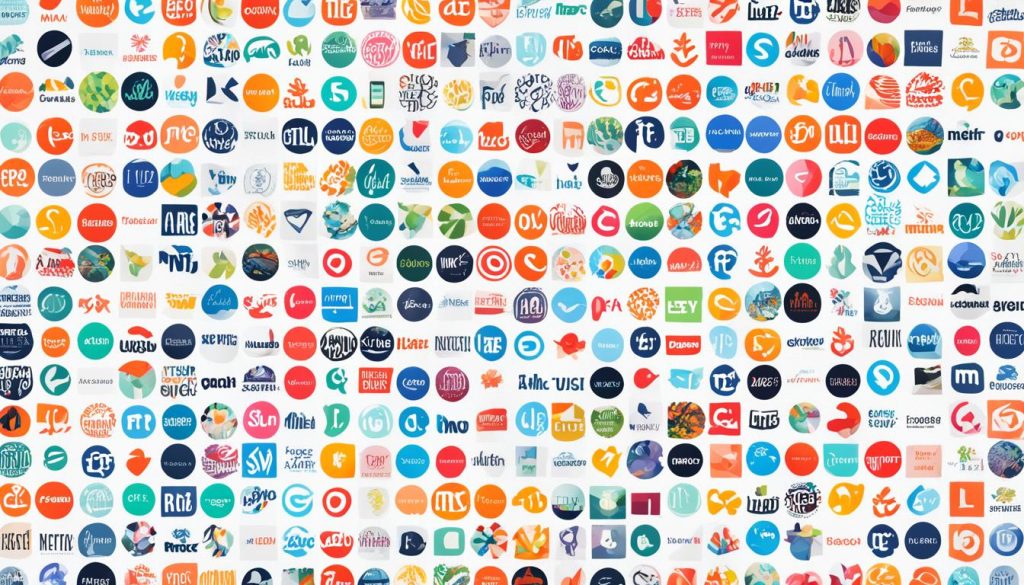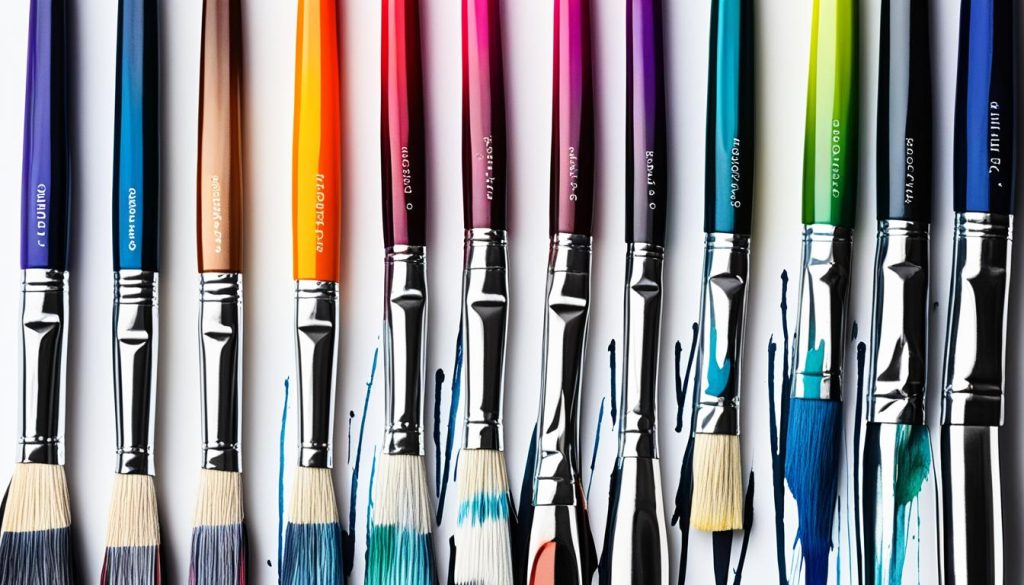Selling art online has never been easier, thanks to the multitude of platforms available to artists. Whether you’re a painter, a sculptor, a photographer, or an illustrator, there’s a perfect online art marketplace waiting for you. In this article, I will guide you through the top art selling websites, helping you find the best place to sell your art online.
Key Takeaways:
- Choose the online art marketplace that aligns with your artistic goals and target market.
- Consider the type of art you want to sell, such as original pieces, prints, or digital files.
- Register your business as a sole proprietorship or LLC to ensure legal compliance.
- Explore different sales channels, including e-commerce platforms and your own website.
- Price your artwork competitively while considering factors like size, complexity, and market demand.
Deciding What Art to Sell and How to Sell It
Before you start selling your art online, it’s important to make decisions about what type of art you want to sell and the medium in which you’ll sell it. This is an essential step in creating a successful online art business.
Types of Art to Sell
When considering what art to sell, you have several options. You can choose to sell your original artwork, which includes one-of-a-kind pieces that you have created. Selling original art allows you to showcase your unique style and creativity to collectors and art enthusiasts.
Another option is to sell copies of your art, such as prints or reproductions. Selling copies allows you to reach a larger audience and offer more affordable options to potential buyers. This can be particularly beneficial if you have limited quantities of your original artwork or if reproductions are in high demand.
If you’re interested in expanding your offering, you can sell digital files of your artwork. This allows customers to purchase and download high-quality digital versions of your art, which they can print or use for personal purposes.
Additionally, you may want to explore the option of selling other artists’ work on your website. This can be a strategic move to diversify your product range and attract customers who are interested in a variety of artistic styles.
Considerations When Choosing Your Art Selling Options
When deciding what art to sell and how to sell it, it’s important to take into consideration your goals and target market. Think about what type of art resonates with your audience and what mediums are popular in the online art market.
You should also consider your production capabilities and resources. Selling original art requires creating new pieces, while selling copies or digital files allows for easier replication and distribution. Think about what aligns best with your artistic process and business model.
Lastly, evaluate the demand and competition in the market for the type of art you want to sell. Research similar artists and analyze what is selling well. By understanding the market trends and preferences, you can make informed decisions on which art selling options are most likely to be successful.
Deciding what art to sell and how to sell it is an important part of building your online art business. By considering your goals, target market, and artistic capabilities, you can make strategic choices that align with your vision and maximize your selling potential.
Registering Your Business
Before you start selling your art and making income from it, it’s important to register your business. This step ensures that you comply with legal requirements and establish a professional presence. There are a few key elements to consider when registering your art business.
Firstly, you need to decide on the legal structure of your business. Two common options for artists are registering as a sole proprietorship or forming a limited liability company (LLC). As a sole proprietorship, you have complete control over your business, but you are personally liable for any debts or legal issues. On the other hand, forming an LLC provides you with legal protection for your personal assets and simplifies record-keeping.
Additionally, depending on your location, you may need to obtain a business license. A business license grants you the legal authority to operate your art business in a specific jurisdiction. The requirements for obtaining a business license may vary depending on your state, city, or county. It’s essential to research and understand your local regulations to ensure compliance.
In some cases, you may also need to apply for an Employer Identification Number (EIN). An EIN is a unique identifier for your business, similar to a social security number for individuals. This number is necessary if you plan to hire employees or if you want to establish business credit.
It’s crucial to check the specific requirements of your state and obtain any necessary licenses or permits. Registering your business not only ensures legal compliance but also provides you with peace of mind and a solid foundation for success.
“Registering my art business gave me confidence and a professional image. It also helped me understand the legal responsibilities that come with selling my artwork online.” – Maria Thompson, Professional Artist
Registering Your Business: Key Points
- Choose the legal structure: Sole proprietorship or LLC.
- Research and obtain any necessary business licenses or permits.
- Consider applying for an Employer Identification Number (EIN) if needed.
- Ensure compliance with local regulations to establish a solid foundation for your art business.
Choosing Your Sales Channels
Once you have decided what art to sell, you need to choose the sales channels where you will showcase and sell your art. There are numerous e-commerce platforms available, such as Etsy, Fineartamerica, Society6, and Amazon. Additionally, you can also choose to sell directly through your own website. It is recommended to sell on multiple channels to increase your art’s exposure and reach a larger audience.
Each platform has its own features and benefits, so it’s important to research and select the ones that align with your goals and target market. Etsy is a popular platform for handmade and vintage items, while Amazon offers a wide reach and customer base. Fineartamerica specializes in selling fine art prints, and Society6 allows artists to sell their artwork on various products.
When selling directly through your own website, you have full control over the customer experience and branding. This can be a great option for artists who want to establish a unique online presence and build a loyal customer base.
Regardless of the platform(s) you choose, it’s important to optimize your product listings with relevant keywords, high-quality images, and detailed descriptions. This will help your art stand out and attract potential buyers.

By leveraging the power of e-commerce platforms and direct sales, you can increase your art sales and expand your reach in the online art market. Take the time to research and select the platforms that best suit your art style, target audience, and business goals. With the right sales channels in place, you can showcase your art to a wider audience and turn your passion into profit.
Determining Pricing
Pricing your artwork is a crucial step in selling art online. When determining the price for your artwork, there are several factors to consider:
- The medium of your artwork: Whether it’s a painting, sculpture, or digital art, the medium plays a role in determining its value.
- The size of your artwork: Larger pieces often require more materials and time to create, which can impact pricing.
- The complexity of your artwork: Intricate details and techniques may increase the value of your art.
- The time invested in creating the artwork: Consider the hours and effort you put into each piece when determining its worth.
It’s important to strike a balance between pricing your art competitively while also valuing your time and skills. Additionally, you should also consider shipping costs and any fees associated with the platform you choose to sell on.
Researching the market and similar artworks can help you determine a fair price for your art. Take a look at the prices of similar pieces by other artists to get a sense of what buyers are willing to pay.
Remember, pricing is not set in stone, and you can always make adjustments based on market demand, feedback, and your own artistic journey. It’s all part of the process of finding the perfect price point that reflects the value of your unique creations.

Marketing Your Online Art Store
Once you have set up your online art store, it’s crucial to market your artwork and attract potential buyers. Effective marketing strategies can help increase the visibility of your art and reach a wider audience. Here are some key tactics to consider:
1. Optimize Your Website for Search Engines (SEO)
Make your online art store more discoverable by implementing SEO techniques. Research relevant keywords related to your artwork and incorporate them into your website’s content, meta tags, and image descriptions. This will help improve your search engine rankings and drive organic traffic to your site.
2. Promote Your Artwork on Social Media
Social media platforms are powerful marketing tools for artists. Create dedicated profiles on platforms like Instagram, Facebook, and Pinterest to showcase your art and engage with potential buyers. Regularly post high-quality images of your artwork, share behind-the-scenes stories, and interact with your audience to build a strong online presence.
3. Utilize Pay-Per-Click Ads
Consider running pay-per-click (PPC) ad campaigns on platforms like Google Ads or social media platforms. Strategically target keywords and demographics relevant to your art to reach potential buyers who are actively searching for similar artworks.
4. Join Relevant Facebook Groups
Participating in Facebook Groups related to art, crafts, or your specific niche can help you connect with fellow artists and potential buyers. Engage in discussions, share your artwork, and contribute valuable insights to establish yourself as an authority in your field.
5. Create a Facebook Store
Expand your online presence by setting up a Facebook Store. This feature allows you to showcase and sell your artwork directly on your Facebook page. With millions of active users, Facebook provides a vast potential customer base for your art.
6. Collaborate with Other Artists
Collaborating with other artists can be mutually beneficial and help expand your reach. Consider partnering with artists whose work aligns with your style or theme. Collaborations can include joint art shows, cross-promotions, or even creating collaborative artworks together.
By leveraging online and offline marketing channels, you can effectively promote your online art store and attract potential buyers. Experiment with different strategies and analyze their impact on your sales to refine your marketing approach over time.
Conclusion
Selling art online opens up a world of opportunities for artists to showcase their talent and connect with a global audience. By strategically choosing the right platforms, setting competitive prices, and implementing effective marketing strategies, artists can successfully sell their artwork and generate income. However, it is important to note that the online art market is highly competitive, and artists must continuously adapt and evolve their selling approach to stay ahead.
One key aspect of selling art online is staying true to your artistic vision. It is essential to create and promote artwork that resonates with your style and passion. Utilize the various resources available, such as social media platforms, search engine optimization (SEO) techniques, and collaborations with fellow artists to boost your visibility and reach a wider audience.
When pricing your artwork, consider factors such as the medium, size, complexity, and time invested in creating each piece. Research the market and examine similar artworks to determine a fair price that reflects the value of your art while remaining competitive. Additionally, be aware of any shipping costs and fees associated with the platforms you choose to sell on.
In summary, selling art online requires careful planning and a proactive marketing strategy. By selecting the right platforms, setting competitive prices, and effectively marketing your artwork, you can maximize your success in the online art market. Stay dedicated to your craft, explore new avenues for promotion, and adapt to the evolving trends to thrive in the digital art landscape.
FAQ
What are the best online platforms for selling art?
How do I decide what art to sell and how to sell it?
Do I need to register my business to sell art online?
What sales channels should I choose to sell my art online?
How do I determine the pricing for my artwork?
How can I market my online art store to attract buyers?
What are the key takeaways for selling art online?
Share this content:






